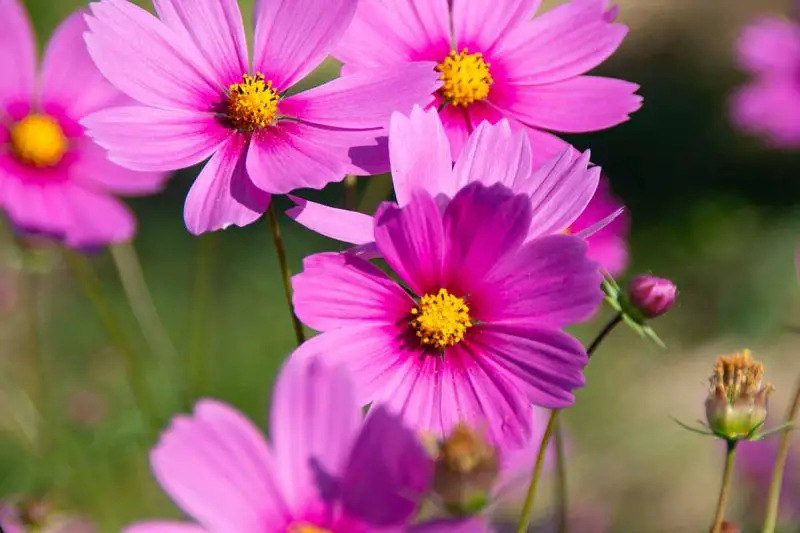If you love a garden that stays bright and lively through the warm months, cosmos flowers are among the best choices you can grow. Their cheerful, daisy-like blooms light up beds, borders, and containers with ease. These delicate yet resilient flowers are known for their long blooming season and effortless charm. With just a little care, cosmos can reward you with continuous color from early summer until the first frost. Understanding their bloom duration—and how to extend it—will help you enjoy an even more spectacular display year after year.
Cosmos are not only beautiful but also incredibly giving plants. They thrive in sunshine, tolerate poor soils, and attract pollinators like bees and butterflies. Yet, many gardeners don’t realize that the length of their blooming season depends on consistent care and timing. Knowing how long cosmos bloom and the factors that affect their flowering period allows you to make the most of their beauty. In this guide, we’ll explore how long cosmos truly bloom, what influences their flowering cycle, and the best techniques to keep them blooming vibrantly all season long.
When Do Cosmos Start Blooming?

Cosmos typically begin blooming in early to mid-summer, depending on the climate and planting time. When sown directly outdoors after the last frost, they usually take around seven to ten weeks to produce their first flowers. In warmer regions, cosmos may start blooming as early as late May, while in cooler climates, they often burst into color by late June. Once they start, they continue to bloom steadily, filling the garden with vibrant hues of pink, white, orange, and crimson. The first wave of flowers marks the beginning of a long and rewarding display that can last for several months.
Their blooming period is closely linked to daylight and temperature. Cosmos thrive best in full sun, where they receive at least six to eight hours of light daily. Extended sunlight promotes strong growth and rapid bud formation, while cooler nights encourage longer-lasting flowers. If planted in a partly shaded location, cosmos may bloom later and produce fewer flowers. The soil temperature also plays a key role—cosmos prefer slightly warm conditions between 65°F and 75°F (18°C–24°C). Once the weather stabilizes and warmth returns, the plants shift quickly from foliage growth to abundant blooming.
Cosmos grown from seedlings or transplants often flower earlier than those started from seed outdoors. By starting seeds indoors four to six weeks before the last frost, you can give them a head start, resulting in earlier blooms. This method is especially helpful in northern regions with shorter summers. Regardless of your approach, cosmos begin their floral display once the days grow long and bright. With good care and patience, their early summer blossoms set the stage for months of continuous color and movement in your garden.
How Long Do Cosmos Bloom During the Season?
Cosmos are celebrated for their exceptionally long blooming period, which typically lasts from early summer until the first frost in fall. Under ideal growing conditions, a single planting can provide continuous color for three to four months or even longer. Once they begin to flower, cosmos maintain a steady rhythm of bud formation, replacing fading blooms with new ones every few days. This natural cycle of renewal makes them one of the most dependable summer flowers. In regions with mild autumns, cosmos can continue blooming until late October or early November, giving gardens a long-lasting touch of color and charm.
The duration of their bloom depends largely on environmental factors such as sunlight, temperature, and soil quality. Cosmos flourish when they receive at least six to eight hours of direct sunlight daily. Consistent warmth between 70°F and 85°F (21°C–29°C) supports healthy bud development and keeps flowers vibrant longer. Overly wet soil, on the other hand, can shorten the bloom time by causing root stress or fungal issues. Well-draining soil with moderate moisture allows the plant to focus its energy on blooming rather than repairing stress damage. In slightly dry soil, cosmos often bloom more abundantly because mild stress triggers more flower production.
Proper maintenance also plays a key role in sustaining their long flowering period. Regular deadheading prevents seed formation and promotes continuous flowering. Occasional light pruning of leggy stems encourages branching, giving the plant more spots to produce new blooms. With this balance of sunlight, well-timed trimming, and gentle care, cosmos can reward you with a nonstop display of flowers throughout the entire growing season. Their endurance and resilience make them a top choice for gardeners who want color that lasts from the first warm days of summer to the final crisp mornings of autumn.
Factors That Affect the Bloom Duration of Cosmos
Sunlight Exposure
Sunlight is the most important factor determining how long cosmos bloom. These flowers are sun lovers, thriving in locations where they receive at least six to eight hours of direct sunlight each day. When grown in full sun, cosmos develop strong stems and abundant buds that open one after another throughout the season. Without enough sunlight, the plants stretch toward the light, becoming tall and weak, with fewer and smaller blooms. Shade not only delays flowering but also shortens the overall blooming period.
Consistent sunlight keeps the plant in a continuous growth and flowering rhythm. In shaded gardens, cosmos often invest their energy into producing foliage rather than flowers. This imbalance reduces the total bloom count. For the longest-lasting display, always plant cosmos in open, bright areas free from large trees or walls that block the light. If you grow them in containers, move the pots to sunny spots as the sun shifts through the seasons. Adequate sunlight ensures not only prolonged blooming but also richer color and stronger, more resilient plants.
Soil Quality and Drainage
The quality of the soil has a direct influence on the length and strength of cosmos blooms. Cosmos prefer moderately fertile, well-draining soil that allows roots to breathe. Soil that is too rich in nutrients, especially nitrogen, encourages lush green growth but fewer flowers. In contrast, slightly lean soil prompts the plant to focus its energy on producing more blossoms rather than excess foliage. This makes cosmos ideal for low-maintenance gardens where the soil isn’t heavily fertilized.
Good drainage is equally essential because cosmos dislike soggy conditions. Standing water can cause root rot and weaken the plant, shortening its blooming period. Mixing in sand or compost improves soil structure and aeration. A slightly dry environment helps cosmos thrive and continuously produce flowers. Once established, they need little supplemental feeding. A monthly addition of compost or a balanced, low-nitrogen fertilizer is enough to sustain steady blooming. When soil conditions remain light and airy, cosmos reward gardeners with months of healthy, colorful blossoms.
Watering and Climate Conditions
Watering habits and local climate play major roles in determining how long cosmos stay in bloom. These plants are drought-tolerant once established, and too much water can do more harm than good. Overwatering leads to soggy soil, which suffocates roots and reduces flowering. Instead, light and infrequent watering encourages deep root growth and keeps the plant strong through heat and dryness. Allow the soil to dry slightly between waterings, especially in cooler or humid climates where moisture lingers longer.
Climate stability is equally important. Cosmos flourish in warm, moderate weather with plenty of sun and low humidity. In extreme heat, flowers may fade faster, while cold snaps can damage buds and shorten the blooming period. In regions with unpredictable weather, providing light afternoon shade and wind protection helps maintain their bloom duration. The ideal environment balances warmth, dryness, and airflow. When watering and climate conditions are well managed, cosmos will continue to thrive and produce flowers consistently until the very end of the season.
How to Extend the Blooming Period of Cosmos
Regular Deadheading
Deadheading is the single most effective way to extend the blooming period of cosmos. As each flower fades, the plant redirects its energy toward forming seeds instead of producing new buds. Removing these spent blooms prevents that shift and keeps the plant in a constant flowering cycle. The process is simple: locate the withered flower and snip the stem just above a pair of healthy leaves or a small developing bud. This encourages branching and stimulates the growth of fresh blossoms.
To maintain a continuous display, inspect your cosmos every few days during peak bloom season. The more consistently you remove faded flowers, the longer the plant will keep blooming. Deadheading also improves air circulation and reduces the risk of fungal issues. By keeping your cosmos clean and tidy, you not only extend their flowering life but also enhance their appearance. Each careful trim gives the plant renewed energy to produce another wave of bright, cheerful blooms that light up your garden for months.
Providing Balanced Nutrition
Proper feeding ensures that cosmos have the strength to sustain blooming for an extended period. These flowers prefer soil that is not overly rich, but they still benefit from light, balanced nutrition. Over-fertilizing, especially with nitrogen-heavy formulas, encourages leafy growth and delays blooming. To keep flowers abundant, use a balanced fertilizer with equal parts nitrogen, phosphorus, and potassium, or enrich the soil monthly with well-rotted compost. Phosphorus, in particular, supports bud formation and prolongs bloom life.
The key is moderation. A small feeding every four to six weeks during the growing season is enough to maintain steady flowering without overwhelming the plant. Always water after fertilizing to help nutrients absorb efficiently. Avoid feeding during extreme heat or drought, as stressed plants can react poorly to fertilizer. Combined with proper sunlight and regular deadheading, balanced nutrition ensures your cosmos stay vigorous and productive, giving you an extended season of lush, colorful blooms that continue to flourish beautifully into late fall.
Pruning and Pinching for New Growth
Pruning and pinching play a vital role in keeping cosmos plants compact and blooming longer. When young plants reach about a foot tall, gently pinch off the top inch of the stem. This simple step encourages branching and creates a fuller, bushier shape that supports more blooms later on. As the season progresses, light pruning of leggy or overgrown stems helps the plant stay balanced and healthy. Removing a few inches from the top of tall stems stimulates new side shoots that will soon produce fresh flowers.
Regular pruning also helps improve airflow through dense foliage, reducing the risk of mildew and keeping the plant vigorous. Avoid cutting too deeply, as cosmos recover best from light, frequent trims rather than drastic cuts. Late in the season, you can rejuvenate tired plants with a moderate trim to trigger another wave of flowering before frost. When combined with steady care, pruning and pinching ensure cosmos remain productive and lively all season long, extending their bloom well beyond what most gardeners expect.
Post-Bloom Care and Seed Management for Cosmos
When the blooming season begins to slow and your cosmos start to fade, proper post-bloom care helps maintain plant health and prepare for the next growing cycle. As autumn approaches, the flowers will gradually decline, and new buds will form more slowly. At this stage, reduce the frequency of deadheading and allow a few blooms to mature naturally. This gives the plant time to produce seeds if you plan to collect them. Continue watering lightly to keep the soil moist but not soggy, as overwatering late in the season can weaken the plant and encourage disease. Removing damaged leaves and trimming excess stems helps keep the plant tidy and prevents fungal buildup as the weather cools.
Once your cosmos have fully completed their flowering phase, stop fertilizing and let them focus on seed development. Seed pods will form at the base of the spent blooms and turn brown as they mature. When the pods are dry and crisp, it’s time to collect them. Gently pinch off the seed heads and separate the seeds over a clean surface. Store the seeds in a paper envelope or breathable bag, keeping them in a cool, dry place until spring. These stored seeds will remain viable for up to two years if protected from moisture. For gardeners who prefer self-seeding, simply leave a few plants untouched at the end of the season. Cosmos readily drop their seeds, often sprouting naturally the following year.
After harvesting seeds or once frost arrives, you can cut back the plants to the ground. Compost the remaining foliage if it is disease-free, or discard it if you see signs of mildew or pests. Lightly turning the soil afterward prepares the bed for future planting. Post-bloom care ensures your cosmos not only finish strong but also set the stage for a healthy, colorful return next year. With a little end-of-season attention, these easygoing flowers will continue to bring vibrant charm to your garden season after season.
Common Problems That Shorten Cosmos Bloom Time
Overwatering and Poor Drainage
Overwatering is one of the most common reasons cosmos stop blooming early. These plants are naturally drought-tolerant and thrive in soil that drains well. When the soil remains too wet, the roots are deprived of oxygen, leading to stress and reduced flowering. Consistently soggy conditions also create the perfect environment for root rot, which can quickly weaken or kill the plant. Even mild overwatering can cause the cosmos to divert its energy into survival rather than producing new flowers.
To prevent this, water deeply but infrequently, allowing the top inch of soil to dry before watering again. If you grow cosmos in containers, make sure the pots have adequate drainage holes. Raised beds or sandy soil mixtures work best for keeping roots aerated. Healthy root systems are essential for prolonged blooming, as they help the plant absorb nutrients efficiently. With proper watering habits and well-draining soil, your cosmos will maintain strong roots and produce flowers for months without decline.
Excessive Fertilization
Fertilizing cosmos too often or using a high-nitrogen formula can significantly reduce flower production. While it might seem that extra nutrients encourage faster growth, excessive nitrogen instead promotes leafy foliage at the expense of blooms. The plant becomes lush and green but produces fewer flowers, shortening its overall blooming season. Over time, the buildup of nutrients can also affect soil balance and microbial activity, making it harder for the cosmos to thrive naturally.
To correct this issue, use fertilizer sparingly. A balanced or low-nitrogen blend applied once every four to six weeks during the growing season is sufficient. Compost and organic matter provide slow, steady nourishment without overwhelming the plant. If your cosmos have already been overfed, skip fertilizing for a month and let the soil naturally rebalance. With less nitrogen, the plant’s focus will shift back to flowering, ensuring a longer and more productive bloom cycle.
Lack of Sunlight
Insufficient sunlight is another major factor that shortens the blooming period of cosmos. These flowers depend on full sun—at least six to eight hours daily—to sustain their flowering cycle. When grown in partial shade or overly cloudy environments, they tend to stretch toward the light, producing fewer and smaller blooms. The lack of direct sun also weakens the stems and delays bud formation, causing the flowering phase to end sooner than expected.
To maximize bloom duration, always plant cosmos in open, sunny areas with minimal shade from trees or nearby structures. If your garden receives limited sunlight, consider growing cosmos in containers that can be moved to sunnier spots throughout the day. Consistent sun exposure encourages steady bud development, vibrant colors, and stronger plants. By ensuring your cosmos receive abundant light, you extend their blooming season and maintain their health until the arrival of frost.
How Weather Affects Cosmos Bloom Longevity
Weather is one of the most influential factors in determining how long cosmos continue to bloom. These sun-loving plants perform best in warm, stable conditions, ideally between 70°F and 85°F (21°C–29°C). When temperatures remain consistent, cosmos grow vigorously and produce a steady flow of buds and blossoms. However, when the heat becomes excessive, the flowers may fade faster, petals may curl, and new buds take longer to appear. On the other hand, prolonged cool or rainy weather can slow down growth and delay blooming. A sudden cold snap or early frost can even end the flowering season abruptly. In very hot regions, providing light afternoon shade helps prevent stress and keeps flowers vibrant for longer periods.
Rainfall and humidity also have a significant effect on the longevity of cosmos blooms. These plants prefer slightly dry conditions and do not respond well to consistently wet soil. Heavy rain can cause the flowers to droop or develop fungal problems such as powdery mildew or gray mold. When the weather turns humid, the lack of airflow around dense foliage makes it easier for moisture to linger, encouraging disease. Gardeners can extend the bloom duration by spacing plants properly and watering only at the base to keep leaves and petals dry. This reduces fungal risks and ensures that the energy of the plant stays focused on flowering rather than recovery.
Wind is another weather element that can influence cosmos blooms. Strong gusts may snap tall stems or cause flowers to fall prematurely. Supporting taller plants with stakes or planting them near natural windbreaks helps minimize damage. Regularly checking for weather changes allows you to adjust care routines—providing extra water during droughts or protection during cold spells. With thoughtful attention to weather conditions, cosmos can maintain their rhythm of bloom and continue filling your garden with color, even through unpredictable seasons.
The Life Cycle of Cosmos Blooms (From Bud to Fade)
The life cycle of a cosmos bloom begins with the development of a small, tightly closed bud. This stage usually appears a few weeks after the plant has established its foliage and started branching. Inside each bud, the flower’s structure is already forming, awaiting the right combination of sunlight and warmth to open. As temperatures rise and daylight increases, the bud slowly expands, revealing vibrant petals that unfold in delicate layers. Within a few days, the bloom reaches its full size and color, drawing pollinators like bees and butterflies. This stage represents the height of the cosmos’ life cycle—when the plant’s energy is most visibly expressed through its flowers.
After the peak bloom period, the flower gradually begins to fade. The petals start to lose color, curl, and eventually dry out, signaling that the flower’s role in reproduction is shifting. Once pollination occurs, the plant directs energy toward seed development at the flower’s base. During this phase, seed pods begin to form, and the bloom slowly transforms into a seed head. If left untouched, these seeds will mature and eventually fall to the ground, naturally self-seeding for the next growing season. This process is the plant’s way of ensuring its survival and spreading its presence across the garden.
Understanding this life cycle is essential for effective garden management. If your goal is to extend the blooming period, you can interrupt the cycle before seed formation by deadheading faded flowers. This encourages the plant to redirect its resources toward new bud production instead of seed development. However, if you wish to collect seeds, allow a few flowers to complete their natural cycle and dry fully on the stem. By knowing when to cut and when to let nature take its course, you can control both the beauty and sustainability of your cosmos garden season after season.
How to Encourage Cosmos to Rebloom After Fading
Encouraging cosmos to rebloom after their first flush of flowers is easy when you understand what the plant needs to restart its flowering cycle. Once the first round of blooms begins to fade, promptly remove the spent flowers by cutting just above the nearest healthy leaf node or side branch. This prevents the plant from focusing on seed production and instead stimulates new growth. Regular deadheading keeps the cosmos in a continuous blooming rhythm, encouraging new buds to form within a week or two. After trimming, lightly water the soil to refresh the plant and reduce stress, especially during hot weather. This gentle care helps the plant redirect its energy efficiently toward producing another wave of blossoms.
Feeding and pruning also play vital roles in promoting reblooming. After the first bloom cycle ends, apply a balanced liquid fertilizer or compost tea to give the plant a nutrient boost. Avoid fertilizers with high nitrogen content, as these encourage leaf growth rather than flowers. Instead, choose one higher in phosphorus to support bud development. At the same time, lightly prune back the plant by about one-third of its height. This rejuvenation pruning stimulates branching and new shoot growth, creating more spots for buds to appear. The cosmos will respond quickly, often producing fresh, vigorous blooms within two to three weeks.
Environmental care is equally important for successful reblooming. Ensure your cosmos receive full sunlight for at least six hours each day, as insufficient light delays bud formation. Maintain well-draining soil and moderate moisture—too much water can stunt recovery, while too little can dry the roots. With consistent deadheading, balanced nutrition, and a bit of patience, your cosmos will reward you with another flush of radiant flowers. This second bloom often appears fuller and lasts longer, extending the life and color of your garden beautifully through the rest of the growing season.
FAQs About Cosmos Blooming
How long do cosmos usually bloom?
Cosmos typically bloom for three to four months, starting in early summer and continuing until the first frost. In warm regions, their flowering can last even longer. With proper care—especially regular deadheading and full sunlight—they produce waves of blossoms that refresh your garden all season long.
Why do my cosmos stop blooming early?
Cosmos often stop blooming early due to overwatering, excessive fertilizer, or lack of sunlight. When given too much nitrogen, they produce more leaves instead of flowers. Poor drainage or shade also weakens the plant. Keeping soil slightly dry, ensuring full sun, and removing faded blooms restores healthy flowering.
Can I make cosmos rebloom after they fade?
Yes, cosmos can rebloom easily with proper care. After the first blooms fade, prune the plant back by about one-third and remove all spent flowers. Lightly fertilize and water the plant to encourage new growth. Within two to three weeks, cosmos usually produce another flush of vibrant blooms.
Do cosmos bloom the first year from seed?
Yes, cosmos are annuals that bloom in their first growing season. When planted after the last frost, they take about seven to ten weeks from seed to flower. Starting seeds indoors in early spring gives them a head start and extends their blooming season by several weeks.
How can I extend the bloom time of cosmos?
To extend bloom time, provide full sunlight, avoid rich soil, and deadhead regularly. Trim leggy stems to encourage branching, and water deeply but infrequently. Applying a light fertilizer every four to six weeks maintains steady growth. These simple steps ensure continuous color from summer through fall.
Conclusion
Cosmos are the perfect symbol of effortless beauty and endless renewal. With the right balance of sunlight, moderate watering, and regular deadheading, these cheerful blooms can fill your garden with color from early summer to the first frost. Their resilience and long flowering period make them a joy for any gardener. Each fading bloom, when cared for properly, gives way to another burst of life. Growing cosmos is more than just planting flowers—it’s nurturing a cycle of beauty that renews itself with every petal, reminding us how simple care can create lasting splendor.






